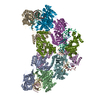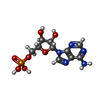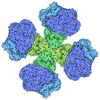+ データを開く
データを開く
- 基本情報
基本情報
| 登録情報 | データベース: PDB / ID: 8y82 | ||||||
|---|---|---|---|---|---|---|---|
| タイトル | Cryo-EM structure of the tetrameric SPARSA gRNA-ssDNA-NAD+ complex | ||||||
 要素 要素 |
| ||||||
 キーワード キーワード | STRUCTURAL PROTEIN/RNA/DNA / RNA BINDING PROTEIN / STRUCTURAL PROTEIN / STRUCTURAL PROTEIN-RNA-DNA complex | ||||||
| 機能・相同性 |  機能・相同性情報 機能・相同性情報 | ||||||
| 生物種 |  Geobacter sulfurreducens (バクテリア) Geobacter sulfurreducens (バクテリア)Escherichia coli 'BL21-GoldpLysS AG' | ||||||
| 手法 | 電子顕微鏡法 / 単粒子再構成法 / クライオ電子顕微鏡法 / 解像度: 3.4 Å | ||||||
 データ登録者 データ登録者 | Zhang, J.T. / Cui, N. / Wei, X.Y. / Jia, N. | ||||||
| 資金援助 | 1件
| ||||||
 引用 引用 |  ジャーナル: Nat Commun / 年: 2024 ジャーナル: Nat Commun / 年: 2024タイトル: Tetramerization-dependent activation of the Sir2-associated short prokaryotic Argonaute immune system. 著者: Ning Cui / Jun-Tao Zhang / Zhuolin Li / Xin-Yang Wei / Jie Wang / Ning Jia /  要旨: Eukaryotic Argonaute proteins (eAgos) utilize short nucleic acid guides to target complementary sequences for RNA silencing, while prokaryotic Agos (pAgos) provide immunity against invading plasmids ...Eukaryotic Argonaute proteins (eAgos) utilize short nucleic acid guides to target complementary sequences for RNA silencing, while prokaryotic Agos (pAgos) provide immunity against invading plasmids or bacteriophages. The Sir2-domain associated short pAgo (SPARSA) immune system defends against invaders by depleting NAD and triggering cell death. However, the molecular mechanism underlying SPARSA activation remains unknown. Here, we present cryo-EM structures of inactive monomeric, active tetrameric and active NAD-bound tetrameric SPARSA complexes, elucidating mechanisms underlying SPARSA assembly, guide RNA preference, target ssDNA-triggered SPARSA tetramerization, and tetrameric-dependent NADase activation. Short pAgos form heterodimers with Sir2-APAZ, favoring short guide RNA with a 5'-AU from ColE-like plasmids. RNA-guided recognition of the target ssDNA triggers SPARSA tetramerization via pAgo- and Sir2-mediated interactions. The resulting tetrameric Sir2 rearrangement aligns catalytic residue H186 for NAD hydrolysis. These insights advance our understanding of Sir2-domain associated pAgos immune systems and should facilitate the development of a short pAgo-associated biotechnological toolbox. | ||||||
| 履歴 |
|
- 構造の表示
構造の表示
| 構造ビューア | 分子:  Molmil Molmil Jmol/JSmol Jmol/JSmol |
|---|
- ダウンロードとリンク
ダウンロードとリンク
- ダウンロード
ダウンロード
| PDBx/mmCIF形式 |  8y82.cif.gz 8y82.cif.gz | 763.7 KB | 表示 |  PDBx/mmCIF形式 PDBx/mmCIF形式 |
|---|---|---|---|---|
| PDB形式 |  pdb8y82.ent.gz pdb8y82.ent.gz | 617 KB | 表示 |  PDB形式 PDB形式 |
| PDBx/mmJSON形式 |  8y82.json.gz 8y82.json.gz | ツリー表示 |  PDBx/mmJSON形式 PDBx/mmJSON形式 | |
| その他 |  その他のダウンロード その他のダウンロード |
-検証レポート
| 文書・要旨 |  8y82_validation.pdf.gz 8y82_validation.pdf.gz | 1.8 MB | 表示 |  wwPDB検証レポート wwPDB検証レポート |
|---|---|---|---|---|
| 文書・詳細版 |  8y82_full_validation.pdf.gz 8y82_full_validation.pdf.gz | 1.9 MB | 表示 | |
| XML形式データ |  8y82_validation.xml.gz 8y82_validation.xml.gz | 136.1 KB | 表示 | |
| CIF形式データ |  8y82_validation.cif.gz 8y82_validation.cif.gz | 201.9 KB | 表示 | |
| アーカイブディレクトリ |  https://data.pdbj.org/pub/pdb/validation_reports/y8/8y82 https://data.pdbj.org/pub/pdb/validation_reports/y8/8y82 ftp://data.pdbj.org/pub/pdb/validation_reports/y8/8y82 ftp://data.pdbj.org/pub/pdb/validation_reports/y8/8y82 | HTTPS FTP |
-関連構造データ
| 関連構造データ |  39030MC  8y7zC  8y80C M: このデータのモデリングに利用したマップデータ C: 同じ文献を引用 ( |
|---|---|
| 類似構造データ | 類似検索 - 機能・相同性  F&H 検索 F&H 検索 |
- リンク
リンク
- 集合体
集合体
| 登録構造単位 | 
|
|---|---|
| 1 |
|
- 要素
要素
-タンパク質 , 2種, 8分子 AEIMBFJN
| #1: タンパク質 | 分子量: 66645.922 Da / 分子数: 4 / 由来タイプ: 組換発現 由来: (組換発現)  Geobacter sulfurreducens (バクテリア) Geobacter sulfurreducens (バクテリア)遺伝子: GSU1360 発現宿主:  参照: UniProt: Q74DF6 #2: タンパク質 | 分子量: 53325.566 Da / 分子数: 4 / 由来タイプ: 組換発現 由来: (組換発現)  Geobacter sulfurreducens (バクテリア) Geobacter sulfurreducens (バクテリア)遺伝子: GSU1361 発現宿主:  参照: UniProt: Q74DF5 |
|---|
-RNA鎖 / DNA鎖 , 2種, 8分子 CGKODHLP
| #3: RNA鎖 | 分子量: 6651.949 Da / 分子数: 4 / 由来タイプ: 合成 由来: (合成)  #4: DNA鎖 | 分子量: 7708.040 Da / 分子数: 4 / 由来タイプ: 合成 由来: (合成)  |
|---|
-非ポリマー , 2種, 6分子 


| #5: 化合物 | ChemComp-MG / #6: 化合物 | |
|---|
-詳細
| 研究の焦点であるリガンドがあるか | Y |
|---|---|
| Has protein modification | N |
-実験情報
-実験
| 実験 | 手法: 電子顕微鏡法 |
|---|---|
| EM実験 | 試料の集合状態: PARTICLE / 3次元再構成法: 単粒子再構成法 |
- 試料調製
試料調製
| 構成要素 | 名称: Tetrameric SPARSAgRNA-ssDNA-NAD+ complex / タイプ: COMPLEX / Entity ID: #1-#4 / 由来: MULTIPLE SOURCES |
|---|---|
| 由来(天然) | 生物種:  Geobacter sulfurreducens (バクテリア) Geobacter sulfurreducens (バクテリア) |
| 由来(組換発現) | 生物種:  |
| 緩衝液 | pH: 8 |
| 試料 | 包埋: NO / シャドウイング: NO / 染色: NO / 凍結: YES |
| 急速凍結 | 凍結剤: ETHANE |
- 電子顕微鏡撮影
電子顕微鏡撮影
| 実験機器 |  モデル: Titan Krios / 画像提供: FEI Company |
|---|---|
| 顕微鏡 | モデル: FEI TITAN KRIOS |
| 電子銃 | 電子線源:  FIELD EMISSION GUN / 加速電圧: 300 kV / 照射モード: SPOT SCAN FIELD EMISSION GUN / 加速電圧: 300 kV / 照射モード: SPOT SCAN |
| 電子レンズ | モード: BRIGHT FIELD / 最大 デフォーカス(公称値): 2500 nm / 最小 デフォーカス(公称値): 1500 nm / C2レンズ絞り径: 70 µm |
| 撮影 | 電子線照射量: 50 e/Å2 / フィルム・検出器のモデル: GATAN K3 (6k x 4k) |
- 解析
解析
| EMソフトウェア | 名称: PHENIX |
|---|---|
| CTF補正 | タイプ: PHASE FLIPPING ONLY |
| 3次元再構成 | 解像度: 3.4 Å / 解像度の算出法: FSC 0.143 CUT-OFF / 粒子像の数: 31412 / 対称性のタイプ: POINT |
| 精密化 | 最高解像度: 3.4 Å |
 ムービー
ムービー コントローラー
コントローラー






 PDBj
PDBj






































































